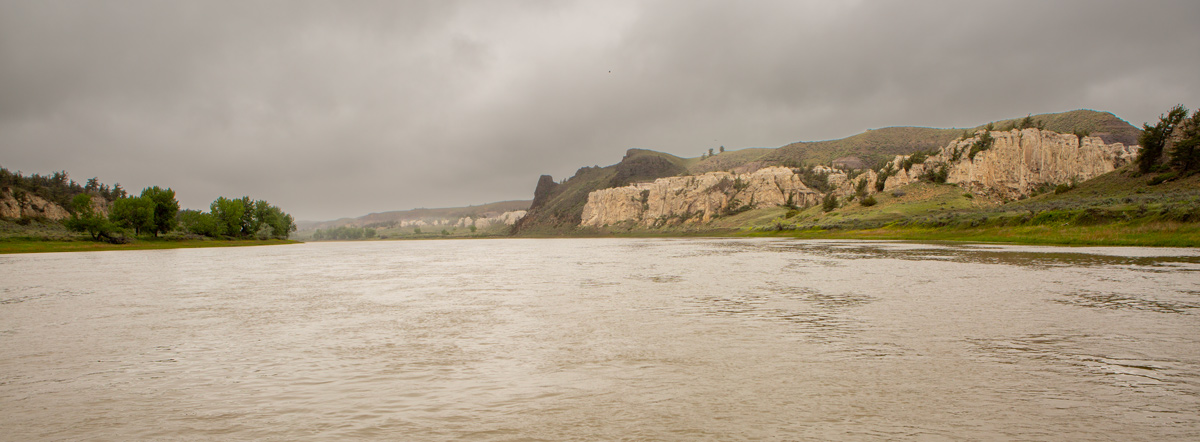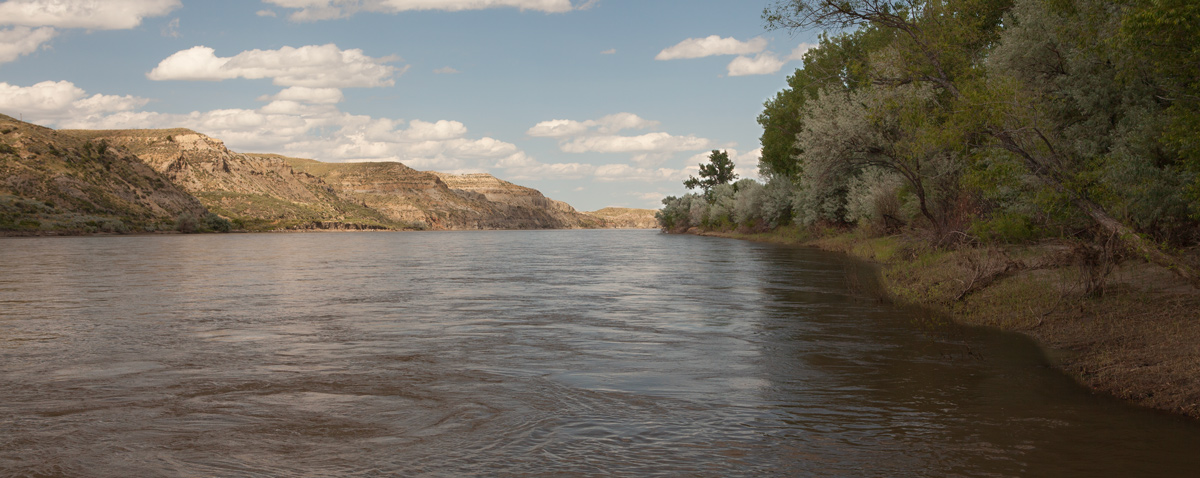On a this rainy day, Lewis and his group paddle down a high and muddy Missouri River passing through the White Cliffs midday. His hunters bag nine bighorn sheep.
Clark and his group are slowed by headwinds as they paddle down the Yellowstone. Before reaching the present Tongue River, they see many signs of beaver and great numbers of bison.
Now far behind Clark, Sgt. Pryor’s mission to the Knife River Villages had failed when all the horses were stolen. By this date, his group of four men were likely paddling their two new bull boats down the river.[1]For more on the captains’ strategy and various groups after leaving Travelers’ Rest, see Dividing Forces at Travelers’ Rest.
Through the White Cliffs (Lewis)
White Cliffs Rain
© 21 May 2016 by Kristopher K. Townsend. Permission to use granted under the Creative Commons Attribution-Share Alike 4.0 International license.
Rainy Weather
Shortly after dark last evening a violent storm came on from N. W. attended with rain hail Thunder and lightning which continued the greater part of the night. no having the means of making a shelter I lay in the water all night. the rain continued with but little intermission all day.
—Meriwether Lewis
White Cliffs
at 11 A. M. we passed that very interesting part of the Missouri where the natural walls appear, particularly discribed in my outward bound journey. we continued our rout untill late in the evening and encamped on the N. E. side of the river at the same place we had encamped on the 29th of May 1805.
—Meriwether Lewis
Nine Bighorn Sheep
on our way today we killed 9 bighorns of which I preserved the skins and skeletons of 2 females and one male; the flesh of this animal is extreemly delicate tender and well flavored, they are now in fine order.
—Meriwether Lewis
Muddy Missouri
the river is now nearly as high as it has been this season and is so thick with mud and sand that it is with difficulty I can drink it. every little rivulet now discharges a torrant of water bringing down immece boddies of mud sand and filth from the plains and broken bluffs.—
—Meriwether Lewis
Clark has a Slow Day
Yellowstone River at Miles City
© 27 July 2011 by Kristopher K. Townsend. Permission to use granted under the Creative Commons Attribution-Share Alike 4.0 International license.
Slowed by Wind
I Set out early this morning wind So hard a head that w made but little way. in the fore part of the day, I saw great numbers of Buffalow on the banks.
—William Clark
Lazeka (Tongue River)
late in the evening I arived at the enterance of a River which I take to be [Nicholas Biddle: called by Indians] the Lazeka or Tongue River . . . . The water of this river is nearly milk worm very muddy and of a lightish brown Colour. the Current rapid and the Chanel Contains great numbers of Snags.
—William Clark
Widening Yellowstone
Beaver is very plenty on this part of the Rochejhone [Yellowstone]. The river widens I think it may be generally Calculated at from 500 yards to half a mile in width
—William Clark
Busted Diplomatic Plan (Pryor)
On 11 August 1806, Lewis commented on the failure of Pryor’s mission to take the horses to the Knife River Villages:
this I fear puts an end to our prospects of obtaining the Sioux Cheifs to accompany us as we have not now leasure to send and enjage Mr. Heney on this service, or at least he would not have time to engage them to go as early as it is absolutely necessary we should decend the river.
—Meriwether Lewis
Weather Diaries
State of the weather at rise
Wind at rise
State of the weather at 4 P. M. Wind at 4 P. M. rain after rain thunder & lightning S W cloudy after rain N E heavy rain last night, continued with small intervales all night
—Meriwether Lewis
State of the weather at Sun rise Wind at Sun rise State of the weather at 4 P. M Wind at 4 P M. cloudy after rain thunder & lightning N. E fair N. a fiew drops of rain accompanied with hard Claps of Thunder and Sharp lightning last night wind hard from the N. E.
—William Clark[2]To assist the reader of this web page, the date column is omitted and some abbreviations have been spelled out.
Notes
| ↑1 | For more on the captains’ strategy and various groups after leaving Travelers’ Rest, see Dividing Forces at Travelers’ Rest. |
|---|---|
| ↑2 | To assist the reader of this web page, the date column is omitted and some abbreviations have been spelled out. |
Discover More
- The Lewis and Clark Expedition: Day by Day by Gary E. Moulton (University of Nebraska Press, 2018). The story in prose, 14 May 1804–23 September 1806.
- The Lewis and Clark Journals: An American Epic of Discovery (abridged) by Gary E. Moulton (University of Nebraska Press, 2003). Selected journal excerpts, 14 May 1804–23 September 1806.
- The Lewis and Clark Journals. by Gary E. Moulton (University of Nebraska Press, 1983–2001). The complete story in 13 volumes.


